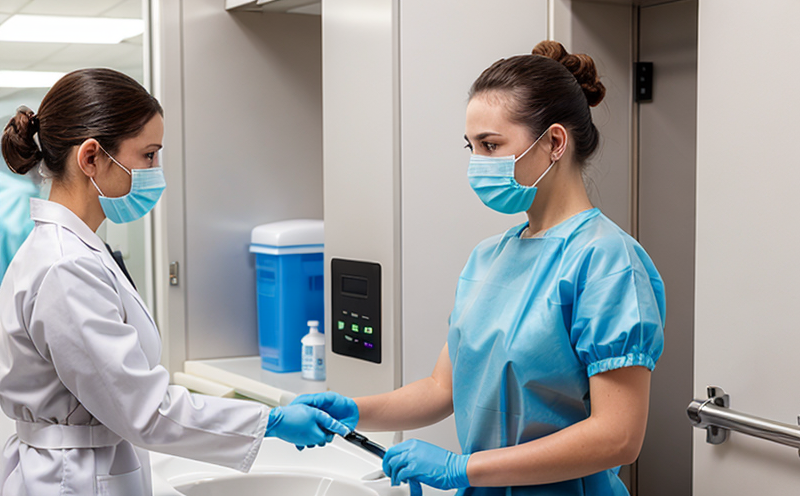Evaluation of antimicrobial coatings on hospital bedding
The evaluation of antimicrobial coatings on hospital bedding is a critical service that ensures the safety and hygiene of patients, visitors, and staff in healthcare facilities. Antimicrobial coatings are designed to inhibit or kill microorganisms such as bacteria, viruses, and fungi, thereby reducing the risk of infection. This service focuses on ensuring these coatings meet stringent standards to protect against cross-contamination and maintain a sterile environment.
Our testing methodology is based on international standards such as ISO 20743:2018, which specifies requirements for antimicrobial textiles used in healthcare facilities. The service involves several steps including preliminary sample preparation, application of the coating, incubation periods, and subsequent analysis to determine efficacy.
For quality managers, compliance officers, and R&D engineers, this service offers detailed insights into how antimicrobial coatings perform under real-world conditions. Hospital bedding is a critical surface that comes into frequent contact with patients, making it essential to ensure these surfaces are as hygienic as possible. Our testing ensures the integrity of these materials, aligning them with healthcare standards and protocols.
The process begins with receiving the samples for evaluation. Samples must be prepared according to ISO guidelines, ensuring they are free from contamination prior to coating application. Once prepared, the bedding undergoes coating, followed by a drying period to ensure uniform application. After coating, the samples are incubated under controlled conditions that simulate real-world scenarios where pathogens might be present.
Following incubation, we assess the effectiveness of the antimicrobial coating using various methods including colony-forming unit (CFU) counts and viable plate count. These tests help determine the reduction in microbial load on the surface after exposure to contaminants. Our lab employs advanced microbiological techniques to ensure accurate results, which are then compared against baseline data from uncoated samples.
This service is not only beneficial for healthcare providers but also for manufacturers of hospital bedding who want to ensure their products meet regulatory requirements and consumer expectations. By using this evaluation process, we help clients make informed decisions about the materials they use in their products, ensuring both quality and safety.
| Parameter | Description |
|---|---|
| Sample Preparation | Preliminary cleaning to ensure no contamination prior to coating application |
| Coching Application | Uniform application of antimicrobial coating |
| Incubation Period | Controlled exposure period to simulate real-world conditions |
| Microbiological Testing | CFU counts and viable plate count for quantifying microbial reduction |
Scope and Methodology
The scope of this service includes the comprehensive evaluation of antimicrobial coatings applied to hospital bedding. The methodology follows international standards such as ISO 20743:2018, which provides a framework for testing antimicrobial textiles in healthcare settings.
- Receive and prepare samples according to ISO guidelines
- Apply the specified antimicrobial coating uniformly across all test samples
- Incubate coated samples under controlled conditions that mimic real-world scenarios
- Perform microbiological tests using CFU counts and viable plate count methods
The results of these tests are used to assess the effectiveness of the antimicrobial coatings in reducing microbial contamination. This ensures that hospital bedding meets the highest standards of hygiene and safety, thereby protecting patients from potential infections.
Customer Impact and Satisfaction
The evaluation of antimicrobial coatings on hospital bedding has a profound impact on customer satisfaction and trust. Hospitals that use our testing service can be assured that their products meet the highest standards, which is crucial for maintaining patient safety and reducing the incidence of healthcare-associated infections (HAIs). This enhances the reputation of the hospital as a provider of safe and effective care.
Quality managers and compliance officers benefit from having concrete evidence that supports the use of these materials. R&D engineers can leverage our findings to innovate new products or improve existing ones, ensuring they are up-to-date with industry standards and best practices.
The positive impact extends beyond internal stakeholders; it also influences external stakeholders such as healthcare providers and patients. By ensuring the highest standards in hygiene, we contribute to a safer environment for all who enter hospital facilities.
Competitive Advantage and Market Impact
- Innovative Testing Methods: Our service uses cutting-edge technology to ensure accurate and reliable results, giving clients a competitive edge in the market.
- Compliance with Standards: By adhering strictly to international standards like ISO 20743:2018, our clients can be confident that their products meet regulatory requirements.
- Enhanced Reputation: Hospitals and manufacturers using this service gain a reputation for excellence in hygiene and safety, which enhances trust among patients and healthcare providers.
- Informed Decision-Making: Our detailed reports provide valuable insights into the performance of antimicrobial coatings, helping clients make informed decisions about their product development and procurement strategies.
This service not only helps companies stay ahead in a competitive market but also ensures they meet the increasing demand for safer healthcare products. By offering this specialized testing, we contribute to the overall improvement of hygiene standards across the industry.





